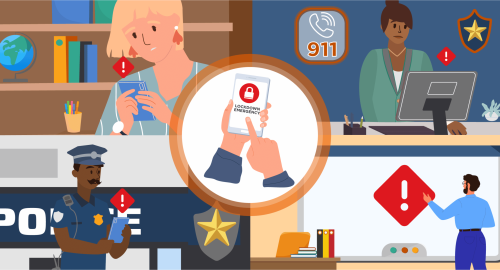Panic alert technology is a school safety best practice – and lies at the top of many schools’ safety lists. School emergency response teams that are considering using a mobile app-based panic alert system in their safety plans might be weighing it against another solution: a proprietary mesh network and badge system. As states and districts evaluate various approaches to keeping students and staff safe, it’s important to have a clear picture of the facts. Here, we examine six reasons why a proprietary hardware-based panic alert system falls short of modern web and app-based panic alert software solutions.
1. App and Web-based systems work on wired, wi-fi & cellular networks
With app-based solutions, the operating network for panic alert technology is simple: it already exists. Unlike proprietary mesh networks which robs budget and resources from your IT department, mobile and web-based panic alerts require no additional physical hardware installation or IT support. App-based solutions create redundancy across your campus with three data transmission options for alerts to be sent and received as follows:
- They can leverage your existing Wi-Fi network; most schools are already investing in Wi-Fi upgrades to improve support of online educational programs
- They work with nationwide cellular networks. Wireless carriers continue investing billions in infrastructure bringing high-speed internet access to everyone
- Additionally, computers may be hardwired directly to the Internet
These three data transmission options mean there would have to be multiple points of failure for an alert not to be sent or received, while single-function mesh networks have a single point of failure at the hub leaving schools vulnerable.
2. Mobile devices are ubiquitous and widely used
With a proprietary hardware-based panic alert system, staff must always have an additional item with them: a badge. That’s just one more thing for busy teachers to remember… just think of how many times YOU have lost or forgotten your ID badge!
On the other hand, app-based panic alerts rely on the mobile phones we already use every day. Like most of us, your staff is conditioned to take their phone with them everywhere they go. And, because the alert uses mobile app technology, it also allows for two-way chat communication during an emergency, giving staff real-time updates for additional context and details to help keep students safe.
App-based solutions utilize modern technology, empowering staff to initiate a response to any type of emergency, talk directly to 911 operators, and provide critical details. In real emergencies, Mobile panic alerts have been used to…
- Convey context about the threat that caused a school to go into lockdown and remind teachers and staff of what to do
- Ask if anyone knows the status of students identified as missing
- Ask for instruction on how to deal with special circumstances (i.e., can children in the cafeteria return to class?)
- Convey class-by-class status updates as the building is cleared
…and because they rely on the mobile devices we already use every day, App-based alerts allow teachers and staff to do all of this with minimal additional training or resources.
3. App-based solutions connect the user directly to 911
For best results in an emergency, school safety experts recommend connecting staff directly with first responders via two-way communication. Solutions that rely on badges do not provide a way for the initiator of an alert to connect directly with 911 operators, failing to enable the user to provide context for the emergency situation or receive important feedback from operators such as medical instructions.
While proprietary hardware-based panic alert systems can notify 911 operators, only mobile app-based solutions connect the person experiencing the emergency directly to first responders. With an app-based panic alert, the person initiating the alert can connect directly to 911 via the mobile application, voice call, or, where available, text-to-911.
The most advanced app-based solutions also support the integration of Public Safety Answering Point (PSAP) software (the software used by 911 operators to answer calls) such as RapidSOS, automatically linking all the data generated by the caller. This gives the 911 operator instant access to important information, such as the location of the caller and the dispatchable address of the school, and thus speeds up emergency response.
4. App-based alerts reduce the frequency of false alarms by 80%
Not only can badge-based alerts be accidentally activated by staff, but they can also be activated (intentionally or otherwise) by non-authorized people such as students.
App-based solutions like Raptor Alert, in contrast, provide:
- A slide button within the app to trigger alerts—which on its own reduces accidental alerting by 80%!
- Second level protection against Raptor Alert misuse with Face ID—so a student can’t pick up the phone and trigger the alert like they could with a badge.
- A configurable list of emergency response options, which means unique alert buttons unique to your district’s specific emergency protocols. Because the alert will communicate the emergency type, staff know how to respond immediately—rather than having to wait for further instruction as an emergency is verified.
5. App-based solutions cost significantly less
The capital expenditure associated with implementing a proprietary hardware-based panic alert system can be enormous, for the same or even lower levels of security. Proprietary mesh networks require the purchase and installation of single-purpose dedicated hardware to send panic alerts. While this may appear to be a one-time purchase, maintenance and management are ongoing expenses. Eventually, the hardware will need to be updated, or else become obsolete.
Raptor’s fully integrated systems cost up to 10 times less upfront, and the ongoing maintenance costs are 50-75% lower than a single-function hardware-based solution that is limited to a single type of emergency response.
Additionally, software-based solutions allow for updates to the system without requiring the expense of replacing an entire system—which makes app-based solutions far more financially sustainable.
6. Costly badge-based solutions can cause your community to question the value
The significant cost of implementing a proprietary hardware-based panic alert system can lead to questions in the community.
For example, the media reports it will cost a Louisiana school district $2.3 million to implement a badge-based alerting system. Despite being marketed as a one-time cost, most IT professionals will tell you any hardware solution will need to be maintained and updated as it becomes quickly obsolete.
The Bottom Line
When it comes to school safety, there are clear benefits to using web and app-based panic alert systems over single-function proprietary mesh network and badge systems. Schedule a demo with one of our specialists to see how Raptor can strengthen your district’s emergency response plan.
Related Resources
School Emergency Response Best Practices
Past school tragedies are reminders of how time equals life, and that we cannot afford even one second of delayed correspondence with responders.
Learn More








